|
FAQs about Limpet Snails, Acmaeidae,
Fissurellidae and more, Scutus, Stomatella
2
Related Articles: Gastropods, Sea Slugs, Mollusks, Abalone,
Related FAQs:
Limpets 1, Limpets 3, Limpets 4, & Limpet Identification 1, Limpet ID 2, Limpet
Behavior, Limpet Compatibility,
Limpet Selection, Limpet Systems, Limpet Feeding, Limpet Disease, Limpet Reproduction, & Marine Snails 1, Marine Snails 2, Marine Snails 3, Marine Snails 4, Snail ID 1, Snail
ID 2, Snail Behavior, Snail Selection, Snail Compatibility, Snail Systems, Snail Feeding, Snail Disease, Snail Reproduction, Mollusks, Sea
Slugs, Abalone,
|
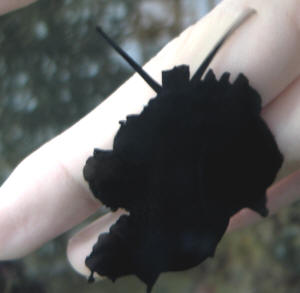
|
|
Identify- Fleshy Slug AKA Fleshy Limpet
10/22/08 Hello crew... <Hello Jessy here> I am
baffled by this ...shall I say....shell-less slug?? It moves all
over the tank sometimes on the glass but usually on the rockwork.
The first picture is very grainy but I wanted you to see it from
the front also and this was the best I had. Thanks in advance for
the help. <Donna, by my estimation that is a fleshy limpet.
See here for further ID
http://www.melevsreef.com/id/fleshy_limpet.html> Regards,
Donna
<Regards, Jessy>
|
[1].JPG) [1].jpg) |
| Hitchhiker Snail Reproduction: Stomatella varia -
1/17/08 Hello WWM, <Hi there!> Thanks for all you do.
<It's a pleasure, indeed!> I have a hitchhiker snail that
I saw trying to reproduce in my tank. I tried to get some pictures
but they were hard to take with the xenia in the way.
<Understandable - can be tough to get good photos of such small
subjects - especially considering water flow/movement.> What are
the chances something like this can reproduce in my system?
I've only seen one of these in my tank. <What you've got
is a Stomatella sp., likely Stomatella varia. They're
harmless/beneficial little herbivores/grazers, highly variable in
color, reproduce readily in our tanks, and can get up to ~1.25'
in length. With such a small shell and so much exposed foot,
you'd think that this species would be very vulnerable to
predation. After all, how can it possibly protect itself if it
can't retract into a shell? Well, nature has allowed for this.
Stomatellids are mostly nocturnal, can move *very* rapidly, and
have the ability to detach the hind portion of their
"foot" (the 'metapodium'). This is similar to
some lizards detaching a portion of their tail when threatened. The
sacrificed segment wriggles and writhes, thus distracting the
predator and supplying it with a tasty tidbit -- allowing the snail
to escape. Potential predators of Stomatellids include the usual
'pickers' - hermits, shrimps, and crabs. Some fish also
find them tasty, but the snails' mostly nocturnal nature helps
to eliminate them from the menu. Sometimes confused with sea slugs,
Stomatellids are actually in the family Trochidae, which includes
the more familiar/recognizable Trochus spp. (Trochus/Top Snails),
Margarites spp. (Margarita Snails), and Norrisia sp (Moon Snails).
Regarding reproduction, unfortunately, if you have only the one
female in your tank, the eggs she released were not fertilized and
are therefore not viable. They will simply become part of the food
chain. Hopefully, there are some small, not yet mature candidates
around for future spawning events. As far as method, Stomatella
spp. are broadcast spawners. The male releases sperm into the water
while the female releases her eggs. In most cases, this means that
the young have very little chance of survival in our tanks.
However, such is not the case with Stomatellids. What tips the
scale in their favor is the fact that the young have a very short
pelagic larval stage, during which they don't need to eat.
After several days of drifting about in the current, they settle to
the rock/substrate as miniature versions of their parents, and
begin to graze. All in all, they're fascinating little
creatures and make terrific additions to a reef tank!> Thanks,
<You're very welcome! Take care. -Lynn> |
|
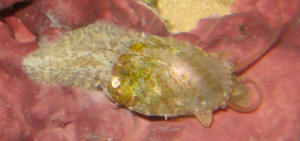 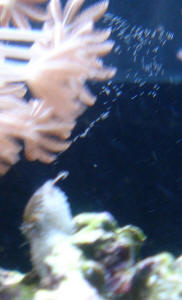
|
Question about the supply of limpets. Bob: It seems that I
have purchased some Man made Florida rock here and there and received
some very unusual creatures called Limpets. I i.d.'d the critter
from "The Modern Coral Reef Aquarium" Volume 1. Svein A.
Fossa & Alf Jacob Nilsen. An example of the scientific name and
picture on Page 188 is Scutus unguis. And yes the animals look very
close to a Nudibranch, except they carry a cone-like shell that looks
like a volcano. Some species cover the shell with what looks like a
mantle. These critters seem to mow down more hair and slime algae than
5 or 7 turbo snails together. Q: Where may one find a supply of these?
None seem to be listed on the FFE web pages? I still have one that
looks more like a moving volcano that does not wrap it's mantle,
and the other was flame orange that did wrap it's mantle. And it
looked just a Nudibranch of sorts. Very pretty!! But the seem not to
like medications. This animal seems to be very low maintenance and very
tolerant of water quality, versus what most Nudibranchs require to stay
alive. Am I looking for this animal in the right place? CH >>
Well, I looked around for limpets as well and couldn't find anyone
listing them for sale... But do want to say a few things about them. I
agree totally with your observations... and assessment... these
Archaeogastropods are great and innocuous cleaner uppers. Having worked
with local (S. Calif.) limpets with different projects, I suspect that
they're not specifically offered for two reasons: They're hard
to extract from hard substrates w/o damaging them... and Folks just
don't know about their usefulness as yet... Unlike Nudibranchs,
many limpets have wide, generalized diets (micro and macrophagous
herbivores)... and also unlike the "naked gill gastropods",
they don't have a tendency toward toxicity... Instead of being
poisonous, limpets have a shielding "home" on their backs...
and lastly, as you observe, many live in "marginal" and
variable environments in the wild... and are therefore reasonably
tolerant of the same in captive situations. Thanks for writing. Bob
Fenner
Limpets A year ago I noticed two limpets in my aquarium. It
is a 90 gallon (6'x1'x2'). My guess is they came in on the
live rock I added 7 months before. The curious thing is this. It took 7
months to see the first 2, and I now have roughly 100 more. They are
black with a white stripe on their back and are actually not
unattractive despite their numbers. They do a good job keeping the
glass, and everything else, clean. They range in size from 1/4 inch to
1 1/2 inch and are found everywhere from the skimmer collection cup
(always a few small ones on the cup of a CPR Bak-Pak), to the live
rock, to the glass. I have about 80 pounds of Fiji live rock, a 1 inch
aragonite sand bed, the CPR, and a couple Hagen 802's for
circulation. I also have Naso, yellow, and regal tangs (1 of each--all
about 3.5 inches), a coral banded shrimp, a false percula clown, and
about a dozen snails and small hermits. There are no corals or
anemones. Ammonia and nitrites are 0. Nitrates are close to 50. S.G. is
1.024. Temp. is 76 and pH is 8.0. I add no chemicals and have 0 algae
other than coralline which covers most everything and has to be scraped
from my glass at least every two weeks. I have two questions. First, is
this an extremely unusual occurrence? In order to identify these things
I had to post pictures to a newsgroup since the few inexpensive books I
have don't even mention them. Second, I'll be adding a dwarf
lionfish and snowflake moray to the system tomorrow. Will either/both
decide to make a feast out of the limpets? If they do, it would
probably be good for them, since, in their numbers, I think the limpets
would be able to sustain enough of a population to meet their dietary
requirements. By the way, when I first set up this system roughly two
years ago, I dosed Kalkwasser for about 2 months to try and get the
coralline to grow, and it didn't. Ever since, I have added no
chemicals (other than synthetic salt and frozen food for the fish) to
the aquarium, and the coralline is almost out of control. It's a
great problem to have. By the way, I have 6 24" fluorescent bulbs.
Four were bought at home depot (cheap bulbs), while the other 2 are
actinic. I also have a large population of feather dusters growing out
of the rock and some have even built tubes of up to 2 inches and are
living in the sand bed. Is this extraordinary luck, or did I
accidentally hit on the aquarium conditions that the worms, coralline,
and limpets thrive in (i.e., low light and not-so-low nitrate)? If my
experience is unusual, I'll probably try to replicate the
environment (minus the fish) in a 29 gallon, devote some study to all
three, and write a paper detailing the conditions for anyone that might
want to duplicate them (though their suitability would be limited to a
fish only situation). Any guidance would be appreciated. Thank you in
advance for your time. Sincerely, Richard Weatherly >> Wow, what
an outstanding query, relating of experience and uplifting story...
Congrats to you. And I think you may be on the verge of a great
commercial success. I have only seen a few cases where the snails
called limpets were so abundant as yours... and they are a blessing...
And your lion and eel will not consume them (different diets all the
way around), but I would do as you say, and save some of these
"Chinese Hats" in another system... if for no other reason,
for just safekeeping. And do "share the wealth" and supply
some to fellow hobbyists... Your relating of the non-supplement use and
results is exemplary by the several meanings of the term... Thank you
for writing... please do consider tallying up your observations and
sending them to one of the hobby magazines... Very useful. Bob
Fenner
Gastropods/Snails/Limpets and an Over Abundance
12/5/05 I'll save space and your having to read by not listing
our tank setup - if you need to know the setup to answer this question,
let me know and I'll oblige. <Okay.> We setup 90 gal tank
with 130 pounds Fiji and Marshal island live rock about 5 months ago.
Within a week, we found a large cap snail hitchhiker...5 months later,
there's so many in the tank (also a few in the refugium) we lose
count to get an exact number. I've read if you know how many snails
you have, you don't have enough, <This sounds like a retailers
slogan'¦I to have heard such ludicrous rules of thumbs such as
this one and the common 'One hermit and snail per gallon rule'
which is to say the least ridiculous.> but is there such a thing as
TOO MANY CAP SNAILS? <If you have an overabundance this means that
there is sufficient algae to support them. The algae is fueled by
nutrients. So if you want the herd to be naturally thinned out I would
check your system for detritus build-ups and watch how much you feed.
Water changes are your friend.> If so, is there a natural predator
for them? <Yes likely any mollusk and crustacean predators such as
wrasses and puffers. However they will not limit their predation to
just your snails, your microfauna population would be adversely
affected as well as any other small critters in your tank.> cheers
<To you too.> Donna <Adam J.>
Snails Everywhere! Hi everyone , I am a little
concerned about crustaceans that are in my tank. I seem to have small ,
about a quarter inch, snails and also limpets in my tank , I have soft
corals as well as mushrooms and polyps. Are these critters harmful to
any of my other occupants . Thanks Rich <Well, Rich- without seeing
them for myself, I can only generalize (gulp!)...Most of the commonly
encountered snails and limpets are harmless...I'd keep an eye on
population levels, and if you start noticing damage or excessive
populations, you may need to remove some. The upcoming "Reef
Invertebrates" by Bob, Anthony, and Steve Pro may be a big help in
identifying these little guys. Take care! Regards, Scott F>
Tech - I from Kent Marine, and limpets 5/22/04 Good
morning to all, <and to you in kind> Just a few questions for
you, hopefully you can help. You usually have all the answers. I am
curious if tech-I iodine supplement from Kent is okay to use. The label
says it has free iodine. My test kit says it is a bad thing.
<somewhat subjective here. There seems to be two "camps"
regarding advocacy of Lugol's strong iodine solution (the nutritive
iodine of color/odor) versus clear Potassium Iodide solutions.
The other troubling thing is several keyhole limpets in my hospital
tank. I believe both can be useful, both can indeed be abused/overdosed
too. I favor Lugol's based solutions FWIW. I'm not a bog fan of
some bottled supplements though... then ones that do not date their
products for products with a definable lifespan/shelf-life. Iodine
loses efficacy over time once mixed ion solution> scoured WWM and
have found two different opinions. Bob says okay and Anthony says they
will eat soft coral flesh. I did find a big one sitting on my flower
leather, so I pulled him off. <some Limpet species are algae
grazers, and some are predators on various reef invertebrates including
corals (these tend to be the colorful ones with frilly/fleshy mantles).
It depends on the species.) Thank you for always being there for me and
my tanks. Thanks, Hopeless reef keeper- Daniel <best of luck,
Anthony>
|
Thanks, and a Story re Stomatella Snails (beh.)
1/29/07 Dear Bob, et. al.: <Greetings John, Mich with you
this evening.> First of all, many thanks to all of you for
your fine WWM resources. You have all helped me gain a tremendous
amount of valuable insight into the reef aquarium hobby, at times
calming my fears, at others helping me form new strategies, and
most always helping me to stay out of (too much) trouble.
<Hehe, this is good.> It is a constant learning experience,
and the challenge is greatly alleviated by useful knowledge and
sense. <Glad to hear!> I have a 75g reef tank with about
100 lbs. of live rock and a 3" sand bed. This tank had been
set up for at least a couple of years by the prior owners, but
had been sadly neglected -- inadequate lighting, insufficient
water changes and regular maintenance, etc., and the live rock
and sand were really not very "live" at all. The sand
was absolutely full of detritus. After moving the entire works,
setting things back up, adding a new skimmer (AquaC Remora Pro),
300w of 10k and 70w of 20k MH lighting, some new additional live
rock and sand and 4 months of babying, this microcosm is now
doing extremely well, and has some very good diversity of life...
not all to my own credit, because you and your advice also
deserve some of the credit. Some "Live Sand Activator"
from Coral Dynamics really kick started the sand bed, and a
couple of other live micro-critter inoculations have the now very
active sand bed well on its way to a stable equilibrium. The tank
never did cycle (measurably, at least), and has never registered
any reading for ammonia, nitrites, nitrates, or phosphates.
<Awesome!> The tank now houses the 2 yellowtail damsels
which came with the original setup, a black velvet neon damsel
(which was rescued from another marine tank after being attacked
nearly to death by other damsels, and who has doubled in size in
3 months), a lawnmower blenny, and a powder blue tang (which I
had great trepidation about adding, but who is healthy, growing,
and truly thriving). I've gradually been adding corals over
the past couple of months - a couple of Acropora frags, two
Montipora, a Pocillopora, a pumping Xenia, and most recently a
yellow Fiji leather. All are thriving (though the Xenia is rather
finicky), have plenty of space, and I am done adding anything for
the foreseeable future. WWM and Bob's and Anthony's books
have really helped me tremendously. <The website and the books
are an invaluable asset to this hobby. I too would
have been at a total loss without them.> I don't have a
question today, but do have a comment / story to share. <Very
good.> After adding something six or so weeks ago, I began
noticing tiny slug-like creatures which grew quickly to about
1/4" to 3/8" length. Within a couple of weeks there
were hundreds of these animals in the tank, most notably after
dark. They were hard to see on the rock since they were
well-camouflaged, but they moved around very quickly, much more
so than the Cerith, Astrea, and turbo snails. After seeing one of
the larger of these spewing milky stuff one morning (obvious to
me that this was a reproductive event), I earnestly needed to
find out what these things were, fearing a pending plague. After
much searching, I finally determined that they were Stomatella,
and that I did not indeed have a problem after all. Their
population has by now become self-regulating, and there is always
a full range of sizes of these snails in the tank. <Most
excellent! These are a great addition to any saltwater
tank.> Yesterday I took out two MaxiJet 1200 powerheads with
Hydor Flo rotating heads (an absolutely wonderful product for the
money, IMO) to (experimentally, at least for now) replace them
with Hydor Koralia powerheads. (So far I'm very impressed
with these, and the general water movement in the tank is much
improved, though time will tell the tale). Upon removing the
Maxijets, I picked off several Stomatella, putting them back into
the tank. After about 30 minutes (with the Maxijets sitting in
the kitchen sink, rinsed in tap water), I got around to their
complete disassembly and cleaning. I found several more of the
Stomatella inside the powerheads, and was very surprised to find
them still alive. <Yes, pretty hardy creatures.> Assuming
that following what they had just been through they were almost
certainly doomed, I took three of them back to the tank and
dropped them into the water anyway. <Always good to be an
optimist.> Fluid dynamics being as it is, all three floated to
the bottom and landed on their backs. They squirmed around for a
few seconds trying to right themselves (they are really adept at
that when they land on rock), but none were able. Then all three
squirreled their heads around and began picking up grains of
sand, placing them on their "bellies" (feet), and moved
the grains along to the back end of their feet. After doing this
with 4-5 grains of sand, they had gained enough weight
(apparently) to squirm one more time and roll over, after which
they took off on their merry ways. I was pretty amazed -- what a
remarkable behavior this was! Is this a great hobby or what??!!
<What a world!!! Amazing isn't it?!?> Sorry
for the length of this message, and again, thanks so much for all
your insight and assistance. <No apologies
please! Thank you for the kind words and sharing your
delightful story! -Mich> Kind Regards, John
Turbo Snail Issues 6/3/06 I had 3 zebra turbo snails.
After a couple weeks I now have 1. It went to the back of the
tank where I have some algae planted and released black pellet
looking things. <Waste pellets, snail poop.> I don't
know if its relieving its self or what but its all around it in
the sand and on its shell. Hopefully you know what
this is. Thank you for your time. Love the site.
<Chris>
|
| Reef Tank Newbie With Unknown Slug: Stomatella sp.,
Overcrowding Issues -- 8/27/08 Hi guys, <Hi there KC,
Lynn here this afternoon.> I have a 34 gallon Solana cube that
has been up and running for a little over three months now, one
month of which was spent cycling. It has approximately two inches
of live sand <Hmmm, please see this link for more information
regarding sand bed depth:
http://www.wetwebmedia.com/dsbdepth.htm> ..and about 30 pounds
of live rock. I am running a 250w MH SunPod lamp 10 hours a day and
have a CPR Bak Pak skimmer hanging off the side of the main
display. I also have the stock skimmer doing whatever it thinks it
is doing in the back sump. I wanted to move the CPR to the built-in
sump, but found out that the pump would not fit back there because
of the limited space even after removing the stock skimmer,
<Yep, that's frustrating all right.> so I thought it
wouldn't hurt to run both. <No, it could be redundant - but
that's not always such a bad thing! If the stock skimmer
isn't producing good skimmate (either in quality or quantity)
you could try running without.> The water readings are: calcium
-- 460 <Would let this fall a bit, to under 450. That is,
assuming that the numbers here are correct (the test kit's
reliable, not out of date). For more information regarding calcium,
please see this link (as well as related links at the top):
http://www.wetwebmedia.com/calcalkmar.htm> pH - 8.4 nitrate -- 0
phosphate - 0 alkalinity - (I use the Red Sea pH & Alk test kit
and it doesn't give a specific number for this. It has a color
chart that shows my water is in the "Normal Range - 1.7 -
2.8") <Not good -- you need specific numbers instead of a
range. I personally use/prefer Salifert for KH/alkalinity testing.
It's quick, easy to use, and most importantly, has a distinct
color change for better/more reliable results.> These are the
only things that I am testing for, should I be testing for more?
<Other than listing salinity/specific gravity, what you have
sounds fine to me. If you were having problems maintaining your
calcium level, I'd recommend a magnesium test kit, but that
doesn't seem to be necessary. Just keep in mind that if you
ever do consider adding supplements such as iodine/iodide,
magnesium, etc you'll need to first acquire those specific
kits. It's important to get a base-line reading as well as
monitor the levels as you increase them (not to mention making sure
they stay within recommended range thereafter.> I am still new
to this and am not too sure which elements I should be testing for.
<You should be good to go. Just be sure to keep up with regular
water changes. These make a big difference in helping to maintain
the extra supplements I mentioned (and more).> For inhabitants,
I have: 1 Fire Angel <I'm not familiar with this term.
I'm guessing it's a Flame Angel (Centropyge loriculus)? If
so, wow are they beautiful.> 1 Velvet Damsel 1 Three Stripe
Damsel <These damsels can become *very* aggressive, especially
in small/crowded systems such as this.> 1 Ocellaris Clown
<Would be nice to have a pair, but at this stocking point, I
wouldn't add one.> 1 Scooter Blenny 2 Fire Shrimp <These
are truly beautiful shrimp, if a bit shy (especially in systems
with strong lighting.> 1 feather duster <Can be difficult to
keep.> 1 2" Tridacna crocea <I would not have added this
until the tank was 6-12 months old at the very earliest.> 1
Turbo snail <Terrific herbivore.> 5 Margarita snails
<Unfortunately, these are cooler water snails that don't
live long in reef systems. The warmer water speeds up their
metabolism. It's a case of 'the candle that burns twice as
bright, burns half as long'.> 2 Cat Eye snails <These,
plus the Turbo listed above, have big appetites and will need a lot
of algae to survive. If there isn't a sufficient amount
existing in the tank, they'll starve to death. You may need to
supplement with dried seaweed/Nori sheets (available at most
regular grocery stores and Asian markets).> 10 or so hermits
<Hmmm, careful here. Hermits are neat, but many reef keepers
(like me) choose to avoid them. They tend to be opportunistic
little fellows that can cause trouble (picking at things, stealing
food from corals, killing small snails, even fellow hermits). This
is especially true when they're in high numbers, as is the case
here. It just makes for more competition for food. Keeping them
well fed, along with supplying plenty of (larger) empty shells,
will help deter (but not necessarily prevent) unwelcome
behavior.> 1 hammer coral 1 torch coral 1 small Acropora frag 1
plate coral a tiny patch of green star polyps that never come out
<Watch out. If/when these do come out, they can spread and take
over like you wouldn't believe. They'll even climb up the
sides of your aquarium. It's best to keep these separate and
away from your main rockwork so they can't spread and cause
problems.> a small rocks with a few Zoanthids on it 2 red
mushrooms <'Shrooms can also take over too, so watch
them.> 4 other bluish mushrooms that were given to me and I
don't know the names of. <Yikes, this is an overcrowded
tank, especially considering the fact that it's only 3 months
old! I would have skipped the Damsels, the Margarita snails, the
two 'Cat eye' snails, the feather duster, clam, and at
least 8 (or all) hermits. There's also a potential for serious
trouble down the road with the various corals you've listed. In
smallish systems such as this, you should really limit the variety
of species to those that will get along best in the long run.
Corals are like any other animal in that they'll fight to
ensure their survival. They do this in a variety of ways, including
chemical warfare or 'allelopathy' (for example many soft
corals/Gorgonians), direct contact with either sweeper tentacles
that sting (Euphyllids, like the hammer and torch coral you have
are particularly notorious for this) or mesenterial filaments that
digest the neighboring coral's tissues, or by simply
overgrowing (for example: green star polyps). Be sure to keep
enough space between the corals you have and move/remove as
necessary. I'd give the torch and the hammer corals at least a
6" buffer zone all the way around them, and keep an eye on
those green star polyps and mushrooms. Mushrooms (Actinodiscus),
although seemingly harmless, can sting adjacent, less aggressive
corals.> Each feeding, I soak the food in V3 Triple Strength.
The food alternates between flake, Cyclops-eeze pellets, krill, and
Mysis. For the corals, clam and feather duster, I dose DT's
live marine phytoplankton once every other day, and dose Marine
Snow once a week. <I'm not personally crazy about this last
product, but hey if it works for you! Just be careful with these
two additives and decrease if you notice excessive algae
production.> Unfortunately, I bought basically every inhabitant
in the tank before learning the error of buying prior to research,
and am trying to keep them healthy and correct errors I have made.
<Good for you.> Is my tank overcrowded? <Oh yeah.> When
I bought all the equipment, sand, and rock, the LFS told me to
cycle it for a month, which I did. Other than that, they happily
sold me whatever I wanted and I admit that I lost a rose tip
anemone and Nudibranch that they sold me not long after I bought
them. <Oh no. What a shame.> It wasn't until that point
that I started doing research on the internet about trying to keep
the rest of the inhabitants alive. I didn't want to lose any of
the remaining inhabitants and felt like a real jerk for losing what
I did. <Well, we've all made mistakes in this hobby. I know
I've made my share and then some! The important thing is that
we learn from them. In your case, it sounds like you just trusted
people that were either lacking in knowledgeable or that were more
concerned with selling their livestock (or both). The good news is
that now you know better. You know to always do your research
*before* purchasing. That combined with quarantining new livestock
will save many lives and much frustration.> That was when I
stumbled across your guys' site and have learned TONS of
invaluable information. <Excellent!> That was less than a
week ago, and it has already saved my Zoanthids from Zoa-eating
Nudi's. <Yikes!> I cannot thank you guys enough for your
wisdom! <LOL While I would never doubt the wisdom of Bob or my
fellow crew-members, the closest I personally come to being wise is
wisecracking!> My question: I have had a couple of these slugs
running around the tank and was not sure if it was harmful to a
reef tank or my inhabitants. <Nope, not at all. They're
absolutely harmless and beneficial.> I was wondering if you guys
could ID it for me. <Yes we can. Oh, you want to know what it
is! It's a species of Stomatella (possibly Stomatella varia), a
commonly seen hitchhiker that reproduces readily in tanks and is
frequently seen grazing film algae.> I tried to search through
your guys' vast resources, but I could not find what this slug
is, or if it is harmful to my reef tank. <No worries, it's a
good guy.> I might have missed it though in the ID section, as I
was trying to find it during work hours, but I was hoping you could
give me a hand. <Sure thing. For more information on Stomatellid
snails, please see the following link:
http://bb.wetwebmedia.com/viewtopic.php?f=25&t=181 Be sure to
also check out the many FAQ's regarding these neat little
snails at WWM. Just go to our Google search engine, and enter the
term Stomatella:
http://www.wetwebmedia.com/WWMAdminSubWebIndex/question_page.htm
> Thanks in advance, your site has really opened my eyes to
aquariums and I would have no doubt lost everything in a matter of
time if I didn't stumble across your Web site. Thanks again! KC
<You're very welcome! Take care, -Lynn> |
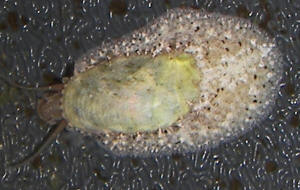 |
| Flatworm Or Nudibranch... Or Maybe Not... (Not)
-- 03/28/08 Hello guys, <<Adam>> I have an
interesting creature in my tank, I've read through the forums
and search across the Internet and I cannot get a positive ID on it
(Even checked the sea slug site you guys listed as a resource.).
<Okay>> It resembles a Nudibranch, although the one
picture I found of something that resembles it, you guys ID'd
it as a flat worm. (http://www.wetwebmedia.com/fltwmid.htm, second
picture from the top, question titled Nudibranch or Flatworm.)
<<Mmm, not a good picture is it? Regardless'¦what
you have is NOT a flatworm>> Flat worms are generally not as
large as this animal is, or at least I thought they weren't.
<<Some do get large>> The guy is around 2 - 2.5"
and only comes out at night, I have seen what seems to be
"antennae" protruding from it. <<Yes>> I
tried several different ways of taking the shot, one strictly with
LED's, others with flashes and/or an LED flashlight. I have
attached a few shots. <<I see them>> One peculiar thing
I witnessed last night was a split in the animals back.
<<Hee-hee! A clue!>> Down the center, which opened
slightly and receded when I placed the light over him. Any ideas?
<<Indeed'¦see below>> I am at a loss and
don't know whether to enjoy the little guy or eject him. I
monitored him for about an hour the other night when I saw him open
up down the middle and never really saw him feeding on anything and
he stays around a rock in the tank with Zoanthids, and a piece of
orange Monti. Only thing I could guess is filter feeding or feeding
off the worms and such in/on the rock. Thanks again, Adam
<<Well Adam, I've seen a couple of these before. What you
have there is Scutus antipodes (Black Limpet, Elephant Snail,
etc.). The 'split' you saw is where the mantel parted (the
mantel comes up from both sides to cover the shell on the animals
back). This critter is reputed by some to be reef safe...others to
be a Cnidarian muncher'¦but all seem to agree it's a
good algae grazer and a prolific breeder. Regards,
EricR>> |
|
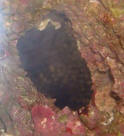
|
| No text? 1/8/08 <See...
Stomatella... BobF> |
|
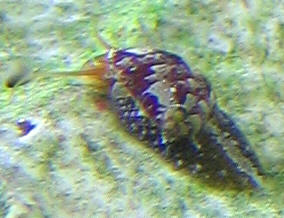
Re: ? Snail ID ayer 1/9/08
Bob - <Joel... Oh there you are!> My apologies. I don't
know what happened to the content and subject line. I would not
be so rude as to intentionally do such a thing. I wrote an email
describing my tank setup and how much you and your crew have
helped me get 6 months into the hobby with nary a problem that
wasn't foreseen. Thanks for the response to what my question
was - "any idea what these might be, perhaps some sort of
Nudibranch?" I will read up on Stomatella now. Thank you
again. Regards, Joel Pippin <Looked like S. varia to me.
Cheers, BobF>
|
| Black Slug... actually is a snail... Scutus spp
12/03/2007 I found this in my tank and thought I would share
the photo. <Thank you for sharing!> I did some research and
found the slug to be (Scutus sp.) <Actually is a snail, not a
slug.> Order: VETIGASTROPODA Superfamily: FISSURELLOIDEA Family:
Fissurellidae. <Yes, more here:
http://www.seaslugforum.net/factsheet.cfm?base=scutus > Our slug
is about 2 1/2 inches and may grow to 5 inches in length. This is a
nocturnal slug and I found it by mistake a few weeks back. <Well
you found it nonetheless.> Just wanted to share. <Thanks
again!> Have a great day, Lis <Thanks Lis, you as well!
Mich> |
|
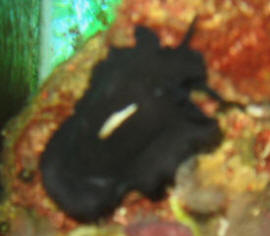 Well done Mich/Mitch... RMF. Well done Mich/Mitch... RMF.
|
| Scutus pics 9/5/07 Hi, <Make me smile>
If there are any Scutus fans out there, here are some fun pics I
took of one of mine. :) Best, Sara <What did the Incredible Mr.
Limpet say? Thrum!!! BobF> |
|
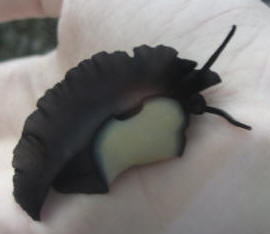 
|
|
|

